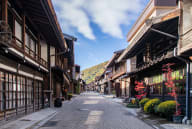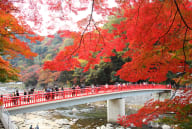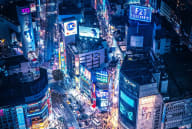
HAKODATE, HOKKAIDO, JAPAN — The workers at this city’s famous fish market are still trying to rub the sleep out of their eyes when I arrive a few minutes after it opens at 5 a.m.
Despite the early morning hour, though, the place is a beehive of activity. Men driving tiny trucks unload giant boxes filled with freshly caught fish. Fishmongers comb through them looking for the largest crabs and squid to put on display. Some of the crabs are as big as a baseball catcher’s mitt.
I watch curiously as one fishmonger wrestles with a massive red crab. The old man with the craggy face tries to tie the crustacean’s razor-sharp claws together with a rubber band, but the crab is putting up a fight. Suddenly, the man blurts out a Japanese curse word, kisama (you bastard). The crab has nipped his finger.
The exchange provides entertainment for the other workers who erupt in laughter when the man angrily tosses the crab aside and nurses his wounded finger.
A festive mood hangs over the old fish market where workers exchange smiles with the foreigner snapping their pictures. And that’s not unusual in this incredibly beautiful city that started welcoming foreign ships in 1854 when Hakodate became the first Japanese port open to Western traders during Japan’s Meiji Era.

Foreigners haven’t stop coming since to this city, the southern gateway to Hokkaido prefecture that fans out from the base of iconic Mount Hakodate into a tranquil bay filled with lots of ships flying foreign flags.
On the street opposite the market is where Hokkaido’s farmers display their famous fruits and vegetables. The island prefecture is Japan’s biggest food producer and is often called the bread basket of Japan.
A farmer wearing white gloves attracts my attention as he carefully places one of his prized Hokkaido cantaloupes on a bed of straw like it was a precious jewel. The incredibly sweet, juicy orb with the orange flesh has been lovingly cared for during its cultivation; Hokkaido farmers even outfit their melons with small hats to protect them from the sun. All that care commands a large price, of course — I fork over 3,000 yen (about $35 Cdn) for one cantaloupe and it’s the best investment of my life.
Hakodate, Hokkaido’s third-largest city, is now one of its most important because this is where the vast agricultural prefecture is connected to the mainland by the Seikan Tunnel, a 53.85km-long engineering marvel that sits 23.3km under the Tsugaru Strait seabed. Completed in 2016, the tunnel, where Japan’s famed bullet trains — Shinkensen — run at speeds of up to 400km/h, has opened beautiful Hokkaido and its remarkable cities and attractions to even more foreigners.
The first “tourist” to be welcomed to Hakodate was the famed American naval hero, Commodore Matthew Perry, who was invited here by the Japanese to survey the port so foreign ships could start arriving. A statue of the great man stands tall in one of Hakodate’s public parks near the base of Mount Hakodate.
There are many other reminders of foreign influence here. Western-style homes, public buildings and churches dominate the slanted streets in the city’s Motomachi (Old Town) area, which offers the best views of the harbour and far off volcanic mountains that dominate this island prefecture.
Among the most impressive buildings in Motomachi are the onion-domed Russian Orthodox Church, the old British and Russian consulates, the massive Koryu-ji Buddhist Temple and the dollhouse-like Old Public Hall, where town meetings and performances were often held.
One of the most popular things for tourists to do is to take the Mount Hakodate Ropeway (cable car) to the top of the dormant volcano at night to see the city’s twinkling lights. What an awesome sight!
However, what foreigners really come to Hakodate to see is Goryōkaku Castle, the massive Western-style fort shaped like a five-pointed star.
The remarkable fortress was designed by Takeda Ayasaburō in 1855 and based on forts created by the famed French engineer Vauban. Goryōkaku is revered by the Japanese because this was the scene of the last battle of the Boshin War, often referred to as country’s civil war, that saw the end of the short-lived Republic of Ezo.
The manicured grounds of the fort are dotted with statues of heroes from that tumultuous period in Japanese history and the 1,600 cherry trees that draw hundreds of thousands of tourists in the spring when they blossom and cover the grounds like a giant pink quilt.

A similarly designed fort sits on Citadel Hill in Nova Scotia’s Halifax and a local guide tells me that each year the Canadian city sends Hakodate a giant Christmas tree that is decorated and floated in the city’s harbour for all to enjoy.
From the tower’s 107m-high observation deck I get stunning views of the star-shaped fort, Mount Hakodate, the city’s skyline and the jagged Yokotsu mountain range off in the distance.
“The observation deck is especially busy during the (spring) cherry blossom season and you can wait many hours in line before gaining entry to the tower,” says Katsuko Kemanai, my guide.
Goryōkaku is also home to the city museum where artefacts from its storied history are preserved and displayed.
In the winter, the fort’s moat freezes and during ancient times, according to the guide, the ice was shaved off and sent to nearby Sapporo to be used in the production of that city’s famous beer.
The streets of Hakodate are dominated by colourful restored trams that date back 100 years. They are used mainly in the downtown core to carry tourists to the city’s many attractions and run only on weekends and national holidays between mid April to October.
Thanks to all the volcanic activity in this area, Hakodate is home to some of Japan’s best hot spring (onsen) hotels. The Yunokawa area just outside Hakodate features many spa hotels and inns and is especially busy during the winter months.


However, you may have to share the hot spring baths with the area’s local monkey population, who regularly soak in the soothing warm baths. The playful monkeys usually hang out in the city’s botanical gardens and love posing for camera-wielding tourists.
Even the monkeys in Hakodate make foreigners feel welcome.
Getting there: Fly to Tokyo with Air Canada and then fly to Hakodate with a regional carrier like Japan Airlines or ANA. You can also take the bullet train from Tokyo to Hakodate, the southern gateway to Hokkaido.
About the writer
Marc Atchison is a veteran journalist and a seasoned traveller with more than 20 years of travel writing experience. As the former Travel Editor of the Toronto Star, Canada's largest newspaper, and now Editor-in-Chief and Senior Writer for TraveLife magazine (Canada) and travelife.ca, Marc has been to over 100 countries in the world. Japan is one of his favorite destinations and he's been there on numerous occasions.
The opinions expressed in the above article do not reflect the views of JNTO. All content and images are property of the writer unless otherwise specified.
*This article is based on the writer's experience before COVID-19.




































































